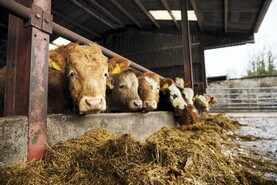While the joint venture announcement between ABP and Fane Valley to acquire the Allen family shares in Slaney caught many by surprise, last week’s announcement on Linden was no great shock.
Once competitors, ABP and Linden became familiar with each other after they became 50:50 business partners in Slaney Foods last year. It was therefore logical that the benefits of extending that partnership to include Fane Valley’s meat interests in Northern Ireland and the north of England would make the outcome of this ABP-Linden joint venture inevitable.
The question now is whether this arrangement will be for the long term, or will Fane Valley want to get out of meat processing altogether, leaving ABP in complete control of Linden and Slaney Foods?

In practice, the move formalises an arrangement that had been developing since Linden and ABP joined together last year to operate Slaney Foods. The processing facilities in Northern Ireland were ideally placed to do supermarket work that met the Red Tractor requirement on meat supplied to UK supermarkets.
What each party brings to the table
In Northern Ireland, Linden has some of the best abattoir and processing facilities available. Fane Valley invested heavily in all areas of the Dungannon factory and have one of the best abattoirs in the business as well as a modern retail packing and new product development facility.
What ABP brings is the best customer portfolio in the UK retail sector and a huge international marketing operation that will ensure the byproducts and lower-value offal cuts will be placed in the best market.
While the ABP facilities have had multiple upgrades over the years, there is general belief that Linden’s factory has the edge.
The ABP Newry factory site in particular is believed to be of huge commercial value for development and with current exchange rates attracting southern shoppers in their droves, it would have appeal to any UK supermarket, particularly those not already in Newry.
Impact on competition
Whatever the future might hold in terms of a continued joint venture or a move by ABP to acquire the remainder of Fane Valley’s interest, the reality is that between ABP’s existing business and Linden Foods, they will account for approximately 40% of Northern Ireland’s cattle kill.
While this is high, the picture is arguably even starker in the lamb trade. Currently only three large exporting factories kill lambs in Northern Ireland – ABP Lurgan, Dunbia and Linden. With this move, Dunbia is the only other option for farmers.
Of course there is the live trade, which accounts for over 40% of lamb sales. But this will have to deal with whatever the outcome of the Brexit negotiations might throw up.
The other twist here is that a major buyer of Northern Ireland lambs is Irish Country Meats, which is part of Slaney Foods, the original joint venture that brought ABP and Linden together.
They have operated independently in the Northern Ireland market to date and farmers will be watching if this continues.
With the recent Dawn-Dunbia deal, lamb processing on the island of Ireland has now become extremely concentrated.
Will farmers be better or worse off?
Only time will answer this question. In recent months, Northern Ireland beef prices have closed the gap with their UK counterparts to the point that it was non-existent. However, it isn’t possible to make the individual factory price comparison in the north, the same as is possible with individual factory prices being published every week in the south.
Therefore, while it will be possible to analyse the relative performance of Slaney Foods before and after the joint venture, this isn’t currently possible with Linden. It would give tremendous confidence to Northern Ireland farmers if both organisations were to make this information available for independent analysis.
Linden Foods UK comprises three processing facilities, two of which are located in Dungannon and Lisnaskea in Northern Ireland, along with another facility situated in Burradon, close to Newcastle in the north of England.
Linden Foods recorded sales of £183m for its financial year ended September 2016, which represented a 4% decline compared to the previous year. The business generated earnings (EBITDA) of £3.2m in the year, which was down by almost a third (-28%) year-on-year. Earnings margins in the business fell 60 basis points to 1.7%.
Linden recorded a 75% decline in operating profits for the year to £251,162, leaving the business with a razor thin profit margin of just 0.1%.
Linden’s facility in Dungannon is the prize asset in the business with capacity to slaughter up to 100,000 head of cattle and more than 200,000 head of sheep per annum. The site accounts for almost 80% of group sales. The other facilities are of a much smaller scale.
In Lisnaskea, Linden controls the Kettyle Irish Foods business, which is a niche operator selling premium dry aged meats to more than 800 high-end restaurants in Ireland, the UK and Europe. Kettyle recorded sales of just under £15.5m, which represents just 8% of the Linden’s overall business.
In the north of England, Linden operates an abattoir at Burradon processing 25,000 head of cattle per annum. Burradon generates annual sales of £24m, which accounts for less than 15% of the entire Linden Foods UK business.
How much did ABP pay for a 50% share of Linden Foods?
The price multiple paid on a meat processing business such as Linden would be a maximum of five to six times earnings (EBITDA). Therefore with Linden Foods generating earnings (EBITDA) of £3.2m for its most recent financial year, the entire business is valued anywhere between £16m and £20m. At this valuation, it is likely a price in the region of £8m to £10m was paid by ABP for the 50% stake it has taken in Linden Foods.






 This is a subscriber-only article
This is a subscriber-only article











SHARING OPTIONS: